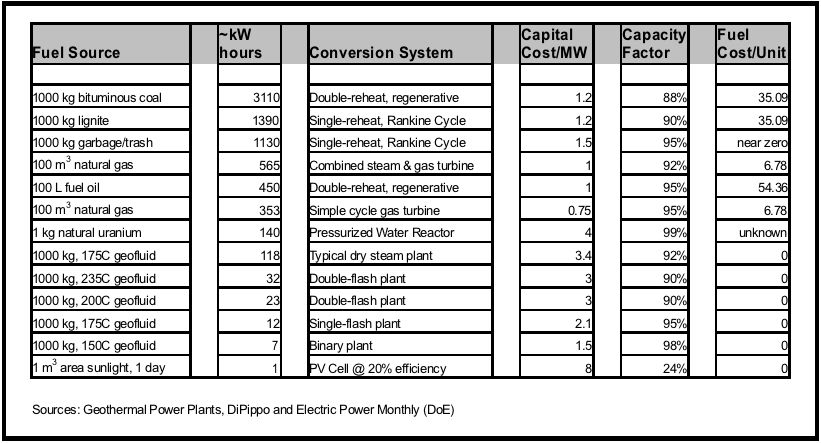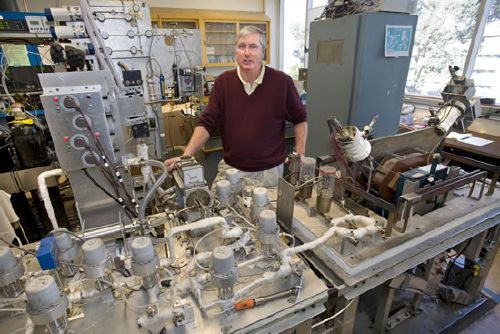Archive for December, 2007
Instructive Chart

If ever you wanted to understand why the industry continues to develop coal plants, even though the negative impact is clear for all to understand, look at the chart above. You’ll notice that coal produces the most energy per unit, at a low cost per unit, and is relatively cheap from a capital cost perspective to build. With clean coal restrictions, the capital cost increases pretty radically (about 3x) but the energy output per unit and fuel cost still remain attractive.
A wind row ought to be added to this chart, but the standard unit was a little tricky to calculate. If anyone has good ideas about how to represent that aspect, please leave a comment. Comments are off for this post
One Redeeming Feature of Energy Bill
Last week we posted an entry excoriating Congress (the Senate in particular) for changes to the Energy Bill which among other things, ripped out production tax credits and renewable portfolio standards. But, credit where credit is due, there is a $95M line item for geothermal R&D which will be earmarked to do the following things:
- Geopressured and oil and gas field co-produced resource production: Clean, renewable geothermal energy can be produced with existing natural gas and oil and gas fields. These uses could revolutionize both the geothermal and the fossil fuel industry.
- Industry-coupled drilling: This program pairs the federal government with geothermal developers to reduce drilling risks and improve drilling precision. Exploration and drilling pose some of the most difficult risks for new geothermal projects and can add significantly to project costs.
- Enhanced geothermal systems (EGS): The MIT and NREL reports suggest that 100,000 megawatts (MW) or more of geothermal power could
be produced using advanced technology. A sustained research and development effort is needed to move towards this goal. - Center for geothermal technology transfer: Such a center, which currently does not exist, is critical to developers seeking information about geothermal prospects and technology advances.
- International Geothermal Collaboration: DOE and US AID are directed to support international geothermal development, particularly related to the African Rift Geothermal Development Facility, Australia, China, France, the Republic of Iceland, India, Japan, and the United Kingdom.
Karl Gawell from the Geothermal Energy Association has a nice write-up of the bill at the GEA website. So it’s not all bad news, but still, the PTC longterm extension and RPS omissions are glaring.
Comments are off for this post
New H3 Exploration Technique

Photo Credit: Roy Kaltschmidt
Via Renewable Energy Access:
In a survey of the northern Basin and Range province of the western United States, geochemists Mack Kennedy of the Department of Energy’s Lawrence Berkeley National Laboratory and Matthijs van Soest of Arizona State University have discovered a new tool for identifying potential geothermal energy resources with no drilling required.
…
Kennedy and van Soest made their discovery by comparing the ratios of helium isotopes in samples gathered from wells, surface springs, and vents across the northern Basin and Range. Helium-three, whose nucleus has just one neutron, is made only in stars, and Earth’s mantle retains a high proportion of primordial helium-three (compared to the minuscule amount found in air) left over from the formation of the solar system. Earth’s crust, on the other hand, is rich in radioactive elements like uranium and thorium that decay by emitting alpha particles, which are helium-four nuclei. Thus a high ratio of helium-three to helium-four in a fluid sample indicates that much of the fluid came from the mantle.
High helium ratios are common in active volcanic regions, where mantle fluids intrude through the ductile boundary of the lower crust. But when Kennedy and van Soest found high ratios in places far from volcanism, they knew that mantle fluids must be penetrating the ductile boundary by other means.
…
“We have never seen such a clear correlation of surface geochemical signals with tectonic activity, nor have we ever been able to quantify deep permeability from surface measurements of any kind,” says Kennedy. The samples they collected on the surface gave the researchers a window into the structure of the rocks far below, with no need to drill.
As a company with a vested interest in the Basin and Range province and in alternate methods of geothermal resource assessment, this is a welcome breakthrough. The research paper describing the technique and results published by van Soest and Kennedy appears in Science is available to subscribers for review. If this method proves reliable, it could open a whole new round of geothermal exploration (and certainly will be used as another tool to assess current geothermal prospects.)
2 comments
Toothless Energy Bill Passes
The Senate eviscerated the energy bill, taking out the long-term production tax credits, the renewable portfolio standard, and reducing the role of renewables dramatically. A disappointing outcome from a disappointing body. Here’s a professional story on the subject via Renewable Energy Access:
Comments are off for this postAfter a hard-fought battle on the political playing field, the renewable energy industries have suffered a difficult defeat. The Senate voted yesterday evening on an Energy Bill that left out the investment and production tax credits and a renewable portfolio standard (RPS), avoiding a Presidential veto but dramatically reducing the role of renewables in Congress’ energy plan.
The Bill passed by a vote of 85-12. It now goes back to the House for approval and then to the President to be signed into law. The White House issued a statement yesterday saying that it would accept the Bill.
The Oil Endgame
This TED Talk by Amory Lovins filmed in 2005 is well worth the investment of 20 minutes. He has posted his book, The Oil Endgame, on a website with a free download. Check it out.








